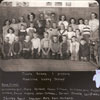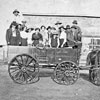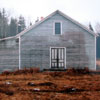Early Years
 The Gilby district was named after Martin Gilbertson, an American of Norwegian ancestry who arrived in the Medicine Valley in 1903. Although Gilby never developed into a township as Eckville had, it remained an important networking centre for Estonians living in the Medicine Valley. The opening of the Gilby Store allowed nearby settlers to purchase groceries, deliver and receive mail, and, most importantly, socialize with neighbours. Before the Gilby Hall was built in 1921, the hall situated above the store functioned as a gathering place for the community. The Gilby Hall was built by a group of Estonian settlers eager to establish a permanent community hall as a means of preserving Estonian customs and traditions. During this time, the Gilby (Kalmu) Cemetery was also built by several Estonian pioneers wanting a peaceful resting place for their friends and family.
The Gilby district was named after Martin Gilbertson, an American of Norwegian ancestry who arrived in the Medicine Valley in 1903. Although Gilby never developed into a township as Eckville had, it remained an important networking centre for Estonians living in the Medicine Valley. The opening of the Gilby Store allowed nearby settlers to purchase groceries, deliver and receive mail, and, most importantly, socialize with neighbours. Before the Gilby Hall was built in 1921, the hall situated above the store functioned as a gathering place for the community. The Gilby Hall was built by a group of Estonian settlers eager to establish a permanent community hall as a means of preserving Estonian customs and traditions. During this time, the Gilby (Kalmu) Cemetery was also built by several Estonian pioneers wanting a peaceful resting place for their friends and family.
 Arthur Eckford arrived in the Medicine Valley in 1902 and settled in an area one and a half miles north of the present town of Eckville. Eckford donated some of his land for the initial development of a general store and post office. Two years later, a bridge linking Eckville with the surrounding farming community and facilitating transportation routes among Estonian farmers was constructed over the Medicine River. By 1912, the Canadian National Railway completed construction of the railway. Within a relatively short time, businesses moved to be closer to the railway, thus establishing Eckville's present location. Main Street soon featured a pool hall, hotel, and drug store. Gus Sestrap, an Estonian settler and one of the first inhabitants of Eckville, owned and operated the General Store. Much to the delight of locals eager to conduct business, the Canadian Bank of Commerce soon opened a banking facility.
Arthur Eckford arrived in the Medicine Valley in 1902 and settled in an area one and a half miles north of the present town of Eckville. Eckford donated some of his land for the initial development of a general store and post office. Two years later, a bridge linking Eckville with the surrounding farming community and facilitating transportation routes among Estonian farmers was constructed over the Medicine River. By 1912, the Canadian National Railway completed construction of the railway. Within a relatively short time, businesses moved to be closer to the railway, thus establishing Eckville's present location. Main Street soon featured a pool hall, hotel, and drug store. Gus Sestrap, an Estonian settler and one of the first inhabitants of Eckville, owned and operated the General Store. Much to the delight of locals eager to conduct business, the Canadian Bank of Commerce soon opened a banking facility.
 By 1920, Eckville had 30 buildings, including two real estate offices, a bakery, a lumber yard, a grain elevator, and a butcher shop. On 3 November 1921, Eckville became a recognized village. Members of the Medicine Valley wholeheartedly accepted new technology as a means of improving their agricultural methods. Technicians connected phone lines between Gilby and Eckville, allowing for improved communication. Alberta's railway system was continually expanding, opening up new transportation networks to other surrounding communities, including Rocky Mountain House and Red Deer. The presence of notable railway companies spurred business with larger corporations. Companies such as John Deere, Imperial Oil, Texaco, and the Alberta Wheat Pool conducted business in the Medicine Valley. With Medicine Valley's economic landscape expanding on a yearly basis, so, too, did the population. By 1966, because it boasted a population surpassing 700, Eckville was formally recognized as a town by the Alberta government.
By 1920, Eckville had 30 buildings, including two real estate offices, a bakery, a lumber yard, a grain elevator, and a butcher shop. On 3 November 1921, Eckville became a recognized village. Members of the Medicine Valley wholeheartedly accepted new technology as a means of improving their agricultural methods. Technicians connected phone lines between Gilby and Eckville, allowing for improved communication. Alberta's railway system was continually expanding, opening up new transportation networks to other surrounding communities, including Rocky Mountain House and Red Deer. The presence of notable railway companies spurred business with larger corporations. Companies such as John Deere, Imperial Oil, Texaco, and the Alberta Wheat Pool conducted business in the Medicine Valley. With Medicine Valley's economic landscape expanding on a yearly basis, so, too, did the population. By 1966, because it boasted a population surpassing 700, Eckville was formally recognized as a town by the Alberta government.
Houses in Medicine Valley:
1902-1940: 40 houses
1921-1940: 46 houses
1941-1965: 13 houses








